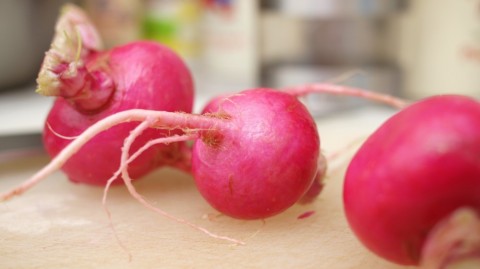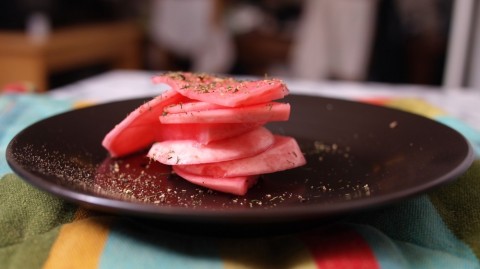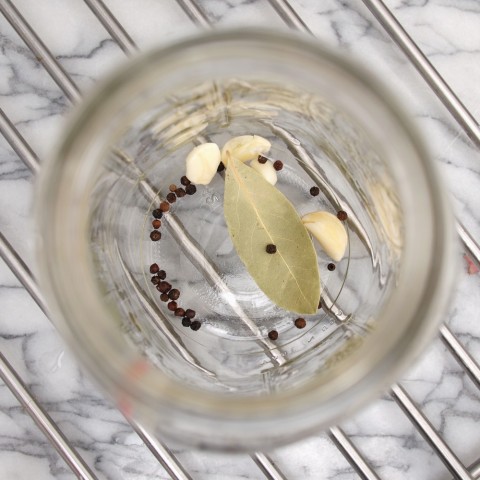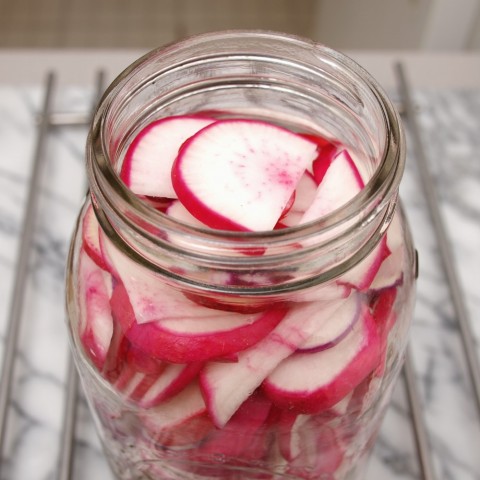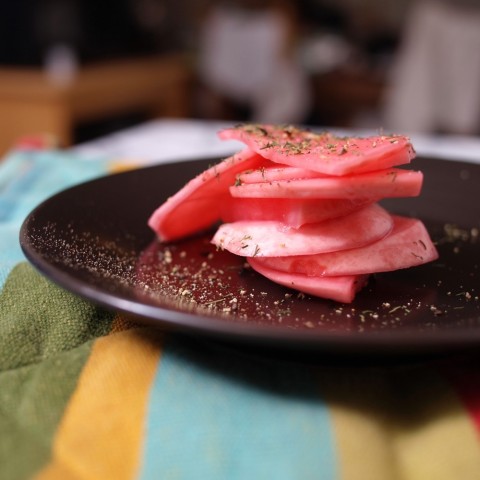Please don’t misconstrue what I’m about to tell you. I do in fact think that sour pickles are great. I make them. I eat them. Like many of you out there, they were my introduction to fermented foods. And I even have a recipe for them here.
But the thing is: cucumbers aren’t really the best candidates for lacto-fermentation. Consider, for a moment, the properties of a good pickle: it’s tangy, salty, juicy, infused with delicious spices like coriander and dill. But most of all, the defining feature of a good pickle is that it’s crunchy. And for all their other pleasant properties, crunchy — with a fermented cucumber — takes some serious doing.
A quick glance around at the usual sources offers a lot of methodologies for keeping your cucumbers firm as they ferment. Sandor Katz (whose book I highly recommend!) suggests foraging some oak leaves to add to your pickle vat. Some websites suggest grape leaves, or horseradish leaves, or even chemical additives to increase the tannin level of your brine, and keep those cukes from turning to mush. I use black tea myself.
But my point is: no matter what method you use, cucumbers require special handling. And even then, their relative crunchiness is kind of hit and miss.
Enter the radish.
I know — I do — that cucumbers have a lot of momentum behind them, being America’s favorite lacto-fermented food and all. But if you can step away from that for a moment, you’ll see the advantage of a root vegetable.
Radishes come pre-crunchy, and they don’t give up that crunch very easily. They’re not juicy the way that a cuke is juicy, but they have some moisture, all the same. Like other root vegetables, they’re basically sponges, soaking up brine — and all the lovely spicy flavors that get steeped in it. And pre-sliced, they’re the perfect flavor-filled convenience food to add to a sandwich, or a salad, or just about anything else you can think of.
Are pickled radishes going to be the same as the jar of Vlasic bread-and-butter slices sitting in your fridge? No. And that’s a good thing. They have a mild sweet-spicy flavor, a faint hint of cabbaginess, and like I said, they do a great job of picking up the flavors of whatever spices you add to the jar. Which means that if you want garlicky? Great! If you want hot? Lovely! If you want sweet like a Chinese pickled turnip? All the better!
Pickle radishes, and the world is your oyster.*
My only caveat with the pickled radishes is their color. Yes, dear friends, they are pink. Submerge red radishes with white flesh in water for a couple of weeks, and the pigment will bleed like an errant red sock in the laundry. If you don’t like this, the fix is easy: either use a white radish like a daikon, or peel them.
Me: I like’m pink. And either of those solutions seems like a lot of effort. My CSA provides fresh and local red radishes, and what comes out are pink pickles. Done and done.
But when they’re your radishes, you can (and should) do what you like. As long as you try them. Because I’m telling you — the result is worth your time.
15-20 Large Radishes, cleaned well and sliced thin
4 cups Filtered Water
2 tbsp (35-40 grams) Sea Salt
3 Cloves of Garlic
20 Whole Peppercorns
1 Bay Leaf
In a saucepan over high heat, add the water and sea salt, stirring until all the solids dissolve. Bring the mix to a rolling boil for a couple of minutes, then remove from the heat, and allow it to come to room temperature, uncovered, so that any chlorine from your local water supply evaporates.
Add the garlic, pepper, and bay leaf to the bottom of a half-gallon wide-mouth jar, and then pack the sliced radishes in fairly tightly, all the way to the top.
When the brine has cooled to room temperature, pour it over the radishes until they are all submerged (you can use the back of a spoon to push them down). Then loosely cover with a screw-on plastic cap, and store in a dark, cool place for ten days to two weeks.
At the end of that time, they’ll be ready to eat. If you choose to leave them out (in said dark, cool place), they’ll continue to ferment, and their flavor will become stronger. If you refrigerate them, they’ll still keep on fermenting, but much more slowly.
It’s your choice. But either way, they should stay good for a couple of months, at least.
* I am absolutely not suggesting that you flavor your radishes with oysters! I have no doubt that that’s a recipe for some ugly health side-effects.
